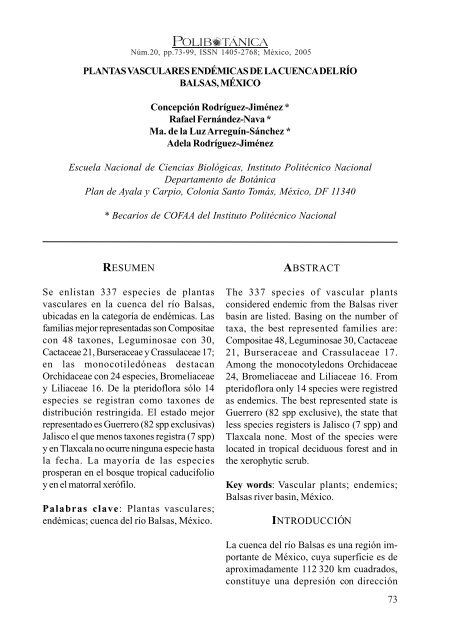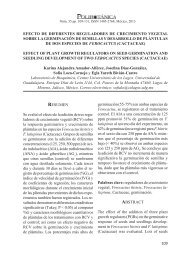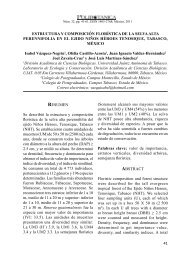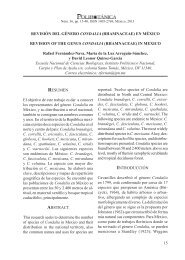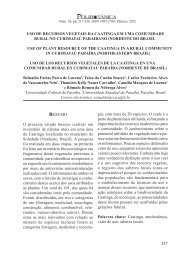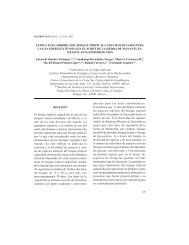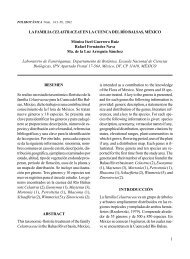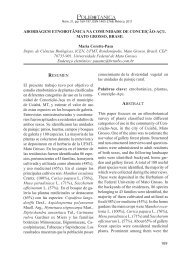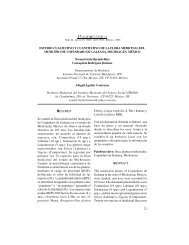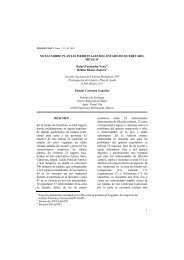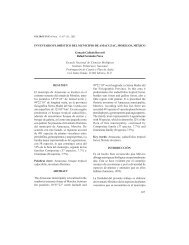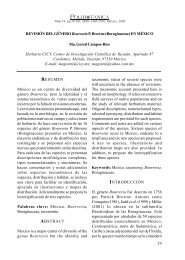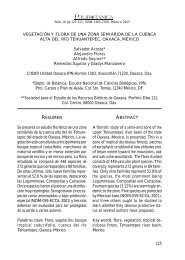Plantas vasculares endémicas de la Cuenca del rÃo ... - Polibotánica
Plantas vasculares endémicas de la Cuenca del rÃo ... - Polibotánica
Plantas vasculares endémicas de la Cuenca del rÃo ... - Polibotánica
You also want an ePaper? Increase the reach of your titles
YUMPU automatically turns print PDFs into web optimized ePapers that Google loves.
Núm.20, pp.73-99, ISSN 1405-2768; México, 2005<br />
PLANTAS VASCULARES ENDÉMICAS DE LA CUENCA DEL RÍO<br />
BALSAS, MÉXICO<br />
Concepción Rodríguez-Jiménez *<br />
Rafael Fernán<strong>de</strong>z-Nava *<br />
Ma. <strong>de</strong> <strong>la</strong> Luz Arreguín-Sánchez *<br />
A<strong>de</strong><strong>la</strong> Rodríguez-Jiménez<br />
Escue<strong>la</strong> Nacional <strong>de</strong> Ciencias Biológicas, Instituto Politécnico Nacional<br />
Departamento <strong>de</strong> Botánica<br />
P<strong>la</strong>n <strong>de</strong> Aya<strong>la</strong> y Carpio, Colonia Santo Tomás, México, DF 11340<br />
* Becarios <strong>de</strong> COFAA <strong>de</strong>l Instituto Politécnico Nacional<br />
RESUMEN<br />
Se enlistan 337 especies <strong>de</strong> p<strong>la</strong>ntas<br />
<strong>vascu<strong>la</strong>res</strong> en <strong>la</strong> cuenca <strong>de</strong>l río Balsas,<br />
ubicadas en <strong>la</strong> categoría <strong>de</strong> endémicas. Las<br />
familias mejor representadas son Compositae<br />
con 48 taxones, Leguminosae con 30,<br />
Cactaceae 21, Burseraceae y Crassu<strong>la</strong>ceae 17;<br />
en <strong>la</strong>s monocotiledóneas <strong>de</strong>stacan<br />
Orchidaceae con 24 especies, Bromeliaceae<br />
y Liliaceae 16. De <strong>la</strong> pteridoflora sólo 14<br />
especies se registran como taxones <strong>de</strong><br />
distribución restringida. El estado mejor<br />
representado es Guerrero (82 spp exclusivas)<br />
Jalisco el que menos taxones registra (7 spp)<br />
y en T<strong>la</strong>xca<strong>la</strong> no ocurre ninguna especie hasta<br />
<strong>la</strong> fecha. La mayoría <strong>de</strong> <strong>la</strong>s especies<br />
prosperan en el bosque tropical caducifolio<br />
y en el matorral xerófilo.<br />
Pa<strong>la</strong>bras c<strong>la</strong>ve: <strong>P<strong>la</strong>ntas</strong> <strong>vascu<strong>la</strong>res</strong>;<br />
endémicas; cuenca <strong>de</strong>l río Balsas, México.<br />
ABSTRACT<br />
The 337 species of vascu<strong>la</strong>r p<strong>la</strong>nts<br />
consi<strong>de</strong>red en<strong>de</strong>mic from the Balsas river<br />
basin are listed. Basing on the number of<br />
taxa, the best represented families are:<br />
Compositae 48, Leguminosae 30, Cactaceae<br />
21, Burseraceae and Crassu<strong>la</strong>ceae 17.<br />
Among the monocotyledons Orchidaceae<br />
24, Bromeliaceae and Liliaceae 16. From<br />
pteridoflora only 14 species were registred<br />
as en<strong>de</strong>mics. The best represented state is<br />
Guerrero (82 spp exclusive), the state that<br />
less species registers is Jalisco (7 spp) and<br />
T<strong>la</strong>xca<strong>la</strong> none. Most of the species were<br />
located in tropical <strong>de</strong>ciduous forest and in<br />
the xerophytic scrub.<br />
Key words: Vascu<strong>la</strong>r p<strong>la</strong>nts; en<strong>de</strong>mics;<br />
Balsas river basin, México.<br />
INTRODUCCIÓN<br />
La cuenca <strong>de</strong>l río Balsas es una región importante<br />
<strong>de</strong> México, cuya superficie es <strong>de</strong><br />
aproximadamente 112 320 km cuadrados,<br />
constituye una <strong>de</strong>presión con dirección<br />
73
Núm. 20:73-99<br />
Diciembre 2005<br />
este-oeste localizada en <strong>la</strong> parte sur<br />
occi<strong>de</strong>ntal <strong>de</strong> México. En el<strong>la</strong> quedan<br />
enc<strong>la</strong>vadas porciones <strong>de</strong> los estados <strong>de</strong><br />
Guerrero, Jalisco, México, Michoacán,<br />
Oaxaca, Pueb<strong>la</strong>, T<strong>la</strong>xca<strong>la</strong> y <strong>la</strong> totalidad <strong>de</strong>l<br />
estado <strong>de</strong> Morelos (fig. 1). Los tipos <strong>de</strong><br />
vegetación sobresalientes son: bosque<br />
tropical caducifolio, bosque tropical<br />
subcaducifolio, bosque espinoso, matorral<br />
xerófilo, bosque <strong>de</strong> encino, bosque <strong>de</strong> pino,<br />
bosque mesófilo <strong>de</strong> montaña y vegetación<br />
acuática y subacuática (Rzedowski, 1978).<br />
La diversidad <strong>de</strong> condiciones ambientales<br />
que se da en esta cuenca le confiere gran<br />
riqueza florística y un alto grado <strong>de</strong><br />
en<strong>de</strong>mismo, situación ya manifestada por<br />
diversos autores que han trabajado en el área<br />
(B<strong>la</strong>nco et al., 1979; Miranda, 1942, 1943,<br />
1947; Rzedowski, 1978, 1991; Sousa y Soto,<br />
1989; Toledo, 1982; Vil<strong>la</strong>señor, 1987).<br />
El objetivo <strong>de</strong>l presente trabajo es realizar un<br />
listado florístico <strong>de</strong> <strong>la</strong>s especies <strong>de</strong><br />
distribución restringida a <strong>la</strong> cuenca <strong>de</strong>l río<br />
Balsas y conocer su ubicación ecogeográfica<br />
en los diferentes estados que <strong>la</strong> componen.<br />
74<br />
ÁREA DE ESTUDIO<br />
La cuenca <strong>de</strong>l río Balsas fisiográficamente está<br />
limitada por el Eje Neovolcánico y <strong>la</strong> Sierra<br />
Madre <strong>de</strong>l Sur, entre <strong>la</strong>s coor<strong>de</strong>nadas 17º00’ y<br />
20º00’ <strong>de</strong> <strong>la</strong>titud Norte, 97º30’ y 103º15’ <strong>de</strong><br />
longitud Oeste (fig. 1.). Al norte se encuentra<br />
el Eje Neovolcanico, <strong>de</strong>s<strong>de</strong> el cerro <strong>de</strong> <strong>la</strong><br />
Malinche, T<strong>la</strong>x., hasta el límite <strong>de</strong> los estados<br />
<strong>de</strong> Jalisco y Michoacán; por el este <strong>la</strong> Sierra<br />
Madre <strong>de</strong> Oaxaca, por el sur y el oeste <strong>la</strong> Sierra<br />
Madre <strong>de</strong>l Sur. Tiene una altitud media<br />
promedio <strong>de</strong> 1 000 m sobre el nivel <strong>de</strong>l mar y en<br />
su parte central <strong>la</strong>s altitu<strong>de</strong>s inferiores osci<strong>la</strong>n<br />
entre los 500 y 200 m, <strong>la</strong> parte más alta <strong>de</strong> <strong>la</strong><br />
cuenca <strong>de</strong> río Balsas se ubica en <strong>la</strong> parte norte<br />
<strong>de</strong>l estado <strong>de</strong> Morelos con altitu<strong>de</strong>s que<br />
osci<strong>la</strong>n entre los 2 800 y 3 100 m. La mayor<br />
parte <strong>de</strong>l área presenta un clima cálido<br />
semiseco, siendo hacia el oriente don<strong>de</strong> se<br />
acentúa más <strong>la</strong> condición <strong>de</strong> ari<strong>de</strong>z y, por<br />
lo tanto, don<strong>de</strong> se encuentra <strong>la</strong> mayor<br />
proporción <strong>de</strong> elementos xerófilos. Para su<br />
mejor manejo administrativo, <strong>la</strong> Comisión <strong>de</strong>l<br />
Río Balsas dividió <strong>la</strong> cuenca en tres regiones<br />
<strong>de</strong>nominadas Alto, Medio y Bajo Balsas. La<br />
primera compren<strong>de</strong> porciones <strong>de</strong> los estados<br />
<strong>de</strong> Guerrero, México, Oaxaca, Pueb<strong>la</strong>, T<strong>la</strong>xca<strong>la</strong><br />
y <strong>la</strong> totalidad <strong>de</strong> Morelos; Medio Balsas<br />
porciones <strong>de</strong> Jalisco, Guerrero, México y<br />
Michoacán y Bajo Balsas porciones <strong>de</strong><br />
Guerrero y Michoacán (anónimo, 1971).<br />
MÉTODOS<br />
Para llevar a cabo este trabajo se tomó como<br />
antece<strong>de</strong>nte el listado florístico <strong>de</strong> <strong>la</strong> cuenca<br />
<strong>de</strong>l río Balsas e<strong>la</strong>borado por Fernán<strong>de</strong>z et al.<br />
(1998) <strong>de</strong>l cual se tiene un registro <strong>de</strong> 4 442<br />
taxones <strong>de</strong>l área en cuestión. Se realizaron<br />
colectas en diferentes periodos y estados que<br />
compren<strong>de</strong> <strong>la</strong> región <strong>de</strong> estudio. A<strong>de</strong>más se<br />
revisaron los ejemp<strong>la</strong>res <strong>de</strong>positados en<br />
diversos herbarios: Escue<strong>la</strong> Nacional <strong>de</strong><br />
Ciencias Biológicas (ENCB), Colegio <strong>de</strong><br />
Posgraduados, Chapingo (CHAPA),<br />
Facultad <strong>de</strong> Ciencias (FCMEX) e Instituto<br />
<strong>de</strong> Biología (MEXU), estos dos últimos<br />
<strong>de</strong>pendientes <strong>de</strong> <strong>la</strong> Universidad Nacional<br />
Autónoma <strong>de</strong> México, así como el <strong>de</strong>l<br />
Instituto Nacional <strong>de</strong> Investigaciones<br />
Forestales (INIF). Para <strong>de</strong>finir <strong>la</strong> distribución<br />
geográfica <strong>de</strong> <strong>la</strong>s especies se revisaron<br />
diversos trabajos, entre otros: B<strong>la</strong>nco et al.,<br />
1979, 1980; Espejo y López, 1992, 1994;<br />
Espejo et al., 2002; García y Galván, 1995;<br />
García y Reyes, 1994; Guzmán et al., 2003;<br />
Lorence, D. H. 1999; Mén<strong>de</strong>z y Vil<strong>la</strong>señor,<br />
2001; Meyran y López, 2003, Ramírez y<br />
Téllez, 1992; Riba, 1993 y Steinmann, 2002.
Rodríguez et al.: <strong>P<strong>la</strong>ntas</strong> <strong>vascu<strong>la</strong>res</strong> endémicas <strong>de</strong> <strong>la</strong> cuenca <strong>de</strong>l río Balsas, México<br />
Fig. 1. Ubicación <strong>de</strong> <strong>la</strong> zona <strong>de</strong> estudio.<br />
75
RESULTADOS Y DISCUSIÓN<br />
Núm. 20:73-99<br />
CONCLUSIONES<br />
Diciembre 2005<br />
De <strong>la</strong>s especies registradas a <strong>la</strong> fecha en<br />
dicha zona <strong>de</strong> estudio, 337 se encuentran<br />
en <strong>la</strong> categoria <strong>de</strong> endémicas (listado<br />
anexo). Por lo que se refiere a <strong>la</strong>s pteridofitas<br />
se <strong>de</strong>tectaron 14 taxones pertenecientes a <strong>la</strong>s<br />
familias Aspleniaceae (1), Polypodiaceae (1),<br />
Pteridaceae (7), Schizaeaceae (1),<br />
Se<strong>la</strong>ginel<strong>la</strong>ceae (1), Thelypteridaceae (1) y<br />
Woodsiaceae (2) (fig. 2). En <strong>la</strong>s dicotiledóneas<br />
se registran 37 familias, <strong>la</strong>s mejor<br />
representadas son <strong>la</strong>s compuestas con 48<br />
taxones, leguminosas con 30, cactáceas con<br />
21 y los «copales» (Burseraceae) al igual<br />
que <strong>la</strong>s crasuláceas agrupan 17;<br />
Euphorbiaceae con 14, otras fami<strong>la</strong>s como<br />
Malvaceae y Rubiaceae <strong>de</strong>stacan también<br />
por el número <strong>de</strong> especies, con 10 cada una<br />
<strong>de</strong> el<strong>la</strong>s (fig. 3). De <strong>la</strong>s nueve familias<br />
que componen el grupo <strong>de</strong> <strong>la</strong>s<br />
monocotiledóneas, <strong>la</strong>s orquí<strong>de</strong>as,<br />
bromelias y liliáceas reúnen el mayor<br />
número, <strong>la</strong> primera 24 y <strong>la</strong>s otras dos<br />
16 cada una (fig. 4).<br />
En re<strong>la</strong>ción a los estados, Guerrero ocupa el<br />
primer lugar en en<strong>de</strong>mismo con 82 especies<br />
exclusivas <strong>de</strong>l total registrado, le sigue el<br />
estado <strong>de</strong> México con 47, Michoacán 44,<br />
Morelos 25, Oaxaca 17, mientras que en<br />
Pueb<strong>la</strong> y Jalisco se registran 8 y 7<br />
respectivamente (fig. 5).<br />
Por lo que se refiere a <strong>la</strong> ubicación ecológica,<br />
el 37% (128 spp) <strong>de</strong> lo registrado<br />
actualmente es exclusivo <strong>de</strong>l bosque tropical<br />
caducifolio, 14% (46 spp) prosperan en el<br />
matorral xerófilo, 12% (40 spp) en el bosque<br />
<strong>de</strong> encino, 10% (33 spp) en el bosque <strong>de</strong><br />
pino-encino y el 27% (90 spp) restante se<br />
distribuye entre el bosque mesófilo, el<br />
bosque espinoso, pastizal y <strong>la</strong> vegetación<br />
secundaria (fig. 6).<br />
76<br />
De manera preliminar y sin consi<strong>de</strong>rar<br />
completo este inventario, el en<strong>de</strong>mismo<br />
específico en <strong>la</strong> cuenca <strong>de</strong>l río Balsas<br />
representa el 7.6 % con re<strong>la</strong>ción al listado<br />
florístico e<strong>la</strong>borado por Fernán<strong>de</strong>z et al.<br />
(1998). El número <strong>de</strong> pteridofitas endémicas<br />
es significativo, ligeramente superior al <strong>de</strong><br />
algunas monocotiledóneas como<br />
Dioscoreaceae (13 spp) y Gramineae (11 spp)<br />
que también <strong>de</strong>stacan por su<br />
representatividad. Algunos taxones que en<br />
el pasado fueron consi<strong>de</strong>rados endémicos<br />
<strong>de</strong> <strong>la</strong> porción oaxaqueña, el caso <strong>de</strong><br />
Cheiloplecton rigidum (Sw.) Fee var.<br />
<strong>la</strong>nceo<strong>la</strong>tum C. Hall ex Mickel & Beitel o<br />
Polystichum smithii Mickel & Beitel<br />
(Arreguín, 2000; Fernán<strong>de</strong>z et al., 2000), han<br />
<strong>de</strong>jado <strong>de</strong> tener esta categoría al ampliar su<br />
área <strong>de</strong> distribución, producto <strong>de</strong> <strong>la</strong>s<br />
colectas recientes o revisiones en otras<br />
entida<strong>de</strong>s <strong>de</strong> <strong>la</strong> República Mexicana y <strong>de</strong><br />
Mesoamérica (Arreguín et al., 2000; Lorea<br />
y Velázquez, 1998; Mickel y Smith, 2004;<br />
Moran y Riba, 1995; So<strong>la</strong>no, 1997; Tejero,<br />
1998; Torres y Tejero, 1998; Zepeda y<br />
Velázquez, 1999). Algo simi<strong>la</strong>r se presenta<br />
con Astragalus cenorrhynchus Barneby<br />
y Robinsonel<strong>la</strong> chiangii Fryxell,<br />
consi<strong>de</strong>radas endémicas en <strong>la</strong> provincia<br />
florística <strong>de</strong>l valle <strong>de</strong> Tehuacán-Cuicatlán<br />
(Mén<strong>de</strong>z et al., 2004) y en este trabajo <strong>de</strong> <strong>la</strong><br />
cuenca <strong>de</strong>l Balsas, situación que valdría<br />
<strong>la</strong> pena reconsi<strong>de</strong>rar con el fin <strong>de</strong> conocer<br />
los límites <strong>de</strong> distribución <strong>de</strong> <strong>la</strong>s mismas.<br />
La riqueza florística <strong>de</strong> <strong>la</strong>s compuestas,<br />
leguminosas y orquí<strong>de</strong>as se ha manifestado<br />
con anterioridad por diversos autores en el<br />
área <strong>de</strong> estudio (Espejo et al., 2002; Jiménez<br />
et al., 2003; Sousa y Delgado, 1993;<br />
Vil<strong>la</strong>señor, 1987); en este trabajo <strong>la</strong>s tres<br />
familias mencionadas representan el 2.5%
Rodríguez et al.: <strong>P<strong>la</strong>ntas</strong> <strong>vascu<strong>la</strong>res</strong> endémicas <strong>de</strong> <strong>la</strong> cuenca <strong>de</strong>l río Balsas, México<br />
PTERIDOPHYTA<br />
Número <strong>de</strong> especies<br />
0 1 2 3 4 5 6 7 8<br />
Aspleniaceae<br />
Polypodiaceae<br />
Pteridaceae<br />
Schizaeceae<br />
Se<strong>la</strong>ginel<strong>la</strong>ceae<br />
Familias<br />
Thelypteridaceae<br />
Woodsiaceae<br />
Fig. 2. Número <strong>de</strong> especies endémicas <strong>de</strong> pteridofitas en <strong>la</strong> cuenca <strong>de</strong>l río Balsas.<br />
DICOTYLEDONEAE<br />
50<br />
45<br />
40<br />
Número <strong>de</strong> especies<br />
35<br />
30<br />
25<br />
20<br />
15<br />
10<br />
5<br />
0<br />
Burseraceae<br />
Cactaceae<br />
Compositae<br />
Crassu<strong>la</strong>ceae<br />
Euphorbiaceae<br />
Leguminosae<br />
Malvaceae<br />
Rubiaceae<br />
Familias<br />
Fig. 3. Familias <strong>de</strong> dicotiledóneas con el mayor número <strong>de</strong> especies endémicas en<br />
<strong>la</strong> cuenca <strong>de</strong>l río Balsas.<br />
77
Núm. 20:73-99<br />
Diciembre 2005<br />
MONOCOTYLEDONEAE<br />
25<br />
20<br />
Número <strong>de</strong> especies<br />
15<br />
10<br />
5<br />
0<br />
Agavaceae<br />
Amaryllidaceae<br />
Bromeliaceae<br />
Commelinaceae<br />
Dioscoreaceae<br />
Gramineae<br />
Iridaceae<br />
Liliaceae<br />
Orchidaceae<br />
Familias<br />
Fig. 4. Número <strong>de</strong> especies endémicas <strong>de</strong> monocotiledóneas en <strong>la</strong> cuenca<br />
<strong>de</strong>l río Balsas.<br />
350<br />
300<br />
Número <strong>de</strong> especies<br />
250<br />
200<br />
150<br />
100<br />
50<br />
0<br />
Total<br />
Guerrero<br />
Jalisco<br />
México<br />
Michoacán<br />
Morelos<br />
Oaxaca<br />
Pueb<strong>la</strong><br />
Estado<br />
Fig. 5. Número <strong>de</strong> especies endémicas exclusivas por estado en <strong>la</strong> cuenca<br />
<strong>de</strong>l río Balsas.<br />
78
Rodríguez et al.: <strong>P<strong>la</strong>ntas</strong> <strong>vascu<strong>la</strong>res</strong> endémicas <strong>de</strong> <strong>la</strong> cuenca <strong>de</strong>l río Balsas, México<br />
Número <strong>de</strong> especies<br />
140<br />
120<br />
100<br />
80<br />
60<br />
40<br />
Simbología<br />
btc: bosque tropical<br />
caducifolio<br />
mx: matorral xerófilo<br />
bQ: bosque <strong>de</strong> encino<br />
bPQ: bosque <strong>de</strong> pinoencino<br />
20<br />
0<br />
btc mx bQ bPQ otros<br />
Ubicación ecológica<br />
Fig. 6. Número <strong>de</strong> especies endémicas con re<strong>la</strong>ción a su ubicación ecológica<br />
en <strong>la</strong> cuenca <strong>de</strong>l río Balsas.<br />
<strong>de</strong>l total registrado, sin embargo<br />
consi<strong>de</strong>ramos como preliminar este<br />
porcentaje ya que en algunas porciones <strong>de</strong><br />
<strong>la</strong> cuenca no se cuenta con datos fi<strong>de</strong>dignos.<br />
La cifra poco significativa <strong>de</strong> especies en los<br />
estados <strong>de</strong> Pueb<strong>la</strong> y Jalisco está re<strong>la</strong>cionada con<br />
<strong>la</strong> pequeña porción que ocupan éstos en <strong>la</strong><br />
cuenca. En el caso <strong>de</strong> T<strong>la</strong>xca<strong>la</strong> no se ha podido<br />
<strong>de</strong>tectar ninguna especie <strong>de</strong> distribución<br />
restringida, el poco material colectado a <strong>la</strong> fecha<br />
y los trabajos <strong>de</strong> índole florística realizados<br />
(Acosta et al., 1991; Azcárraga, 1983; Castillejo<br />
y Ramírez, 1992; Vibrans, 1997, 1998) indican una<br />
consi<strong>de</strong>rable perturbación <strong>de</strong> <strong>la</strong> vegetación y<br />
no resaltan especies <strong>de</strong> esta categoría.<br />
Es interesante hacer notar que un poco<br />
más <strong>de</strong>l 50% <strong>de</strong> <strong>la</strong>s especies endémicas<br />
registradas (173 spp.) se ubican en los<br />
estados <strong>de</strong> Guerrero, México y Michoacán,<br />
principalmente en el bosque tropical<br />
caducifolio, lo que pone <strong>de</strong> manifiesto <strong>la</strong><br />
riqueza florística <strong>de</strong> esos tres estados en<br />
<strong>la</strong> <strong>de</strong>presión <strong>de</strong>l Balsas, consi<strong>de</strong>rada a su<br />
vez relevante por <strong>la</strong> concentración <strong>de</strong> taxa<br />
exclusivos (Rzedowski, 1991).<br />
En el futuro es necesario seguir recopi<strong>la</strong>ndo<br />
información, principalmente en aquel<strong>la</strong>s<br />
porciones poco representadas <strong>de</strong> <strong>la</strong> cuenca,<br />
con el fin <strong>de</strong> tener un mayor número <strong>de</strong> datos<br />
dignos <strong>de</strong> crédito y <strong>de</strong>terminar <strong>la</strong>s áreas <strong>de</strong><br />
concentración <strong>de</strong> riqueza <strong>de</strong> especies o «is<strong>la</strong>s<br />
ecológicas» (Rzedowski, 1991), así como<br />
aquel<strong>la</strong>s que se encuentran en situación<br />
vulnerable.<br />
79
Núm. 20:73-99<br />
Diciembre 2005<br />
LITERATURA CITADA<br />
Acosta, P.R., G.L.Galindo F. y L.V. Hernán<strong>de</strong>z<br />
C., 1991. Listado preliminar <strong>de</strong> <strong>la</strong> flora<br />
fanerogámica <strong>de</strong>l estado <strong>de</strong> T<strong>la</strong>xca<strong>la</strong>.<br />
Gobierno <strong>de</strong>l Edo. T<strong>la</strong>xca<strong>la</strong>, T<strong>la</strong>xca<strong>la</strong>.<br />
Folleto 12, 44 pp.<br />
Anónimo, 1971. Generalida<strong>de</strong>s sobre <strong>la</strong><br />
<strong>Cuenca</strong> <strong>de</strong>l Río Balsas. Memoria Gráfica.<br />
Comisión <strong>de</strong>l Río Balsas. Secretaría<br />
<strong>de</strong> Agricultura y Recursos Hidráulicos.<br />
México.<br />
Arreguín-Sánchez, M.L., 2000. Estudio sobre<br />
pteridofitas en el estado <strong>de</strong> Oaxaca,<br />
México. Simposio sobre Biodiversidad<br />
<strong>de</strong> Oaxaca: Un enfoque hacia <strong>la</strong> conservación<br />
<strong>de</strong> áreas prioritarias. 13-15 septiembre,<br />
2000. Centro Interdisciplinario<br />
<strong>de</strong> Investigación para el Desarrollo Integral<br />
Regional <strong>de</strong> Oaxaca. Sta. Cruz<br />
Xoxocotlán, Oaxaca, México. 13 pp.<br />
Arreguín-Sánchez, M.L.; R. Fernán<strong>de</strong>z-Nava,<br />
R.Pa<strong>la</strong>cios-Chávez y D.L.Quiroz-García,<br />
2000. Pteridoflora ilustrada <strong>de</strong>l estado<br />
<strong>de</strong> Querétaro, México. Instituto Politécnico<br />
Nacional-Secretaria <strong>de</strong> Educación<br />
Pública. México, DF, 430 pp.<br />
Azcárraga, R.R., 1983. Estudio florístico <strong>de</strong><br />
p<strong>la</strong>ntas arvenses en tres cultivos <strong>de</strong>l<br />
estado <strong>de</strong> T<strong>la</strong>xca<strong>la</strong>. Tesis <strong>de</strong> licenciatura,<br />
Escue<strong>la</strong> Nacional <strong>de</strong> Estudios<br />
Profesionales, Iztaca<strong>la</strong>, Universidad<br />
Nacional Autónoma <strong>de</strong> México. México,<br />
DF, 28 pp + 46 mapas.<br />
B<strong>la</strong>nco, M.,O. Castillo y C.Toledo, 1979. Estudio<br />
preliminar <strong>de</strong> <strong>la</strong>s cactáceas <strong>de</strong> <strong>la</strong><br />
cuenca baja <strong>de</strong>l río Balsas. Cactáceas<br />
y Suculentas Mexicanas, 24(4):78-89.<br />
B<strong>la</strong>nco, M., O. Castillo y C.Toledo, 1980.<br />
Estudio preliminar <strong>de</strong> <strong>la</strong>s cactáceas <strong>de</strong><br />
<strong>la</strong> <strong>Cuenca</strong> Baja <strong>de</strong>l Río Balsas. Segunda<br />
parte. Cactáceas y Suculentas<br />
Mexicanas, 25(1):7-20.<br />
Castillejos-Cruz, Carlos y R.I. Ramírez-Ramírez,<br />
1992. Florística y Vegetación <strong>de</strong>l estado<br />
<strong>de</strong> T<strong>la</strong>xca<strong>la</strong>. Tesis profesional <strong>de</strong><br />
biólogo. Escue<strong>la</strong> Nacional <strong>de</strong> Estudios<br />
Profesionales, Zaragoza, Universidad<br />
Nacional Autónoma <strong>de</strong> México. México,<br />
DF, 103 pp.<br />
Davidse, G., M. Sousa y S. Knapp, 1995.<br />
Psilotaceae a Salviniaceae. En Morán, R.C.<br />
y R. Riba (Eds.), Flora Mesoamericana.<br />
vol. 1. Universidad Nacional Autónoma<br />
<strong>de</strong> México-Missouri Bot. Gar<strong>de</strong>n-Natural<br />
History Museum. 470 pp.<br />
Espejo Serna, A. y A.R. López-Ferrari, 1992.<br />
Las monocotiledóneas mexicanas.<br />
Una sinopsis florística. Parte I. Consejo<br />
Nac. <strong>de</strong> <strong>la</strong> Flora <strong>de</strong> México, A.C.-<br />
Universidad Autónoma Metropolitana.<br />
México, DF, 76 pp.i-xii.<br />
, 1994. Las monocotiledoneas<br />
mexicanas. Una sinopsis florística. Parte<br />
III. Consejo Nac. <strong>de</strong> <strong>la</strong> Flora <strong>de</strong> México,<br />
A.C.-Universidad Autónoma Metropolitana<br />
Comisión Nacional <strong>de</strong> <strong>la</strong><br />
Biodiversidad. México, DF, 73 pp.<br />
Espejo-Serna, A., J.García-Cruz, A.R.López-<br />
Ferrari, R.Jiménez-Machorro y L.<br />
Sánchez-Saldana, 2002. Orquí<strong>de</strong>as <strong>de</strong>l<br />
estado <strong>de</strong> Morelos. Orquí<strong>de</strong>a (Méx.),<br />
16. 332 pp + 53 láminas.<br />
80
Rodríguez et al.: <strong>P<strong>la</strong>ntas</strong> <strong>vascu<strong>la</strong>res</strong> endémicas <strong>de</strong> <strong>la</strong> cuenca <strong>de</strong>l río Balsas, México<br />
Fernán<strong>de</strong>z-Nava R., C. Rodríguez-Jiménez,<br />
M.L. Arreguín-Sánchez y A. Rodríguez-<br />
Jiménez,1998. Listado florístico <strong>de</strong> <strong>la</strong><br />
cuenca <strong>de</strong>l río Balsas. México.<br />
Polibotánica, 9:1-151.<br />
Fernán<strong>de</strong>z-Nava, R., M.L. Arreguín-Sánchez,<br />
C. Rodríguez-Jiménez y A. Rodríguez-<br />
Jiménez, 2000. Flora y vegetación <strong>de</strong> <strong>la</strong><br />
<strong>Cuenca</strong> <strong>de</strong>l Río Balsas, Oaxaca, México.<br />
Simposio sobre Biodiversidad en<br />
Oaxaca: Un enfoque hacia <strong>la</strong> conservación<br />
<strong>de</strong> áreas prioritarias. 13-15 <strong>de</strong> septiembre,<br />
2000. Centro Interdisciplinario<br />
<strong>de</strong> Investigación para el Desarrollo Integral<br />
Regional <strong>de</strong> Oaxaca. Sta. Cruz,<br />
Xoxocotlán, Oaxaca, México.13 pp.<br />
García, M.P.T. y J. Reyes S., 1994. El<br />
en<strong>de</strong>mismo en <strong>la</strong> flora fanerógamica <strong>de</strong><br />
<strong>la</strong> Mixteca Alta, Oaxaca- Pueb<strong>la</strong>, México.<br />
Acta Botánica Mexicana, 27: 53-73<br />
García-Mendoza, A. y R. Galván V., 1995. Riquezas<br />
<strong>de</strong> <strong>la</strong>s familias Agavaceae y<br />
Nolinaceae en México. Bol. Soc. Bot.<br />
México, 56: 7-24.<br />
Guzmán, U., S. Arias y P. Dávi<strong>la</strong>, 2003. Catálogo<br />
<strong>de</strong> cactáceas mexicanas. Universidad<br />
Nacional Autónoma <strong>de</strong> México-<br />
Comisión Nacional <strong>de</strong> <strong>la</strong> Biodiversidad.<br />
México, DF, 315 pp.<br />
Jiménez-Ramírez, J., M. Martínez-Gordillo,<br />
S. Valencia-Ávalos, R.Cruz-Durán,<br />
J.L.Contreras-Jiménez, E.Moreno-<br />
Gutiérrez y J.Calónico-Soto, 2003.<br />
Estudio florístico <strong>de</strong>l municipio Eduardo<br />
Neri, Guerrero. An. Inst. Biol. Univ.<br />
Nac. Autón. Méx. Sér. Bot., 74 (1): 79-<br />
142.<br />
Lorea-Hernán<strong>de</strong>z, F. y E. Velásquez, 1998.<br />
Pteridofitas. Lista <strong>de</strong> los taxa y su distribución<br />
geográfica en <strong>la</strong> entidad. En<br />
Diego-Pérez, N y R.M. Fonseca (Eds.)<br />
Estudios florísticos en Guerrero, No.<br />
9. Facultad <strong>de</strong> Ciencias, Universidad<br />
Nacional Autónoma <strong>de</strong> México. México,<br />
DF, 83 pp.<br />
Lorence, D.H., 1999. A nomenc<strong>la</strong>tor of<br />
Mexican and Central American<br />
Rubiaceae. Monographs Systematic<br />
Botany, 73. Missouri Bot. Gar<strong>de</strong>n Press.<br />
177 pp.<br />
Mén<strong>de</strong>z-Larios, I. y J.L. Vil<strong>la</strong>señor R., 2001.<br />
La familia Scrophu<strong>la</strong>riaceae en México:<br />
diversidad y distribución. Bol. Soc.<br />
Bot. México, 69: 101-121.<br />
Meyran, G.J. y L. López-Chávez, 2003. Las<br />
crassu<strong>la</strong>ceas <strong>de</strong> México. Soc. Mexicana<br />
<strong>de</strong> Cactología, A.C. México, D.F. 234<br />
pp + 52 pp fotografía + indice.<br />
Mickel, J.T. y A.R. Smith, 2004. The<br />
pteridophytes of Mexico. Memoirs<br />
New York Bot. Gar<strong>de</strong>n, 88: 1-1055.<br />
Miranda, F., 1942. Estudios sobre <strong>la</strong> vegetación<br />
<strong>de</strong> México III. Notas generales sobre<br />
<strong>la</strong> vegetación <strong>de</strong>l SO <strong>de</strong>l Estado <strong>de</strong><br />
Pueb<strong>la</strong>, especialmente <strong>de</strong> <strong>la</strong> zona <strong>de</strong><br />
Itzocan <strong>de</strong> Matamoros. An. Inst.<br />
Biol.Univ. Nac. Méx., 13(2):417-450.<br />
_______, 1943. Estudios sobre <strong>la</strong> vegetación<br />
<strong>de</strong> México IV. Algunas características<br />
<strong>de</strong> <strong>la</strong> vegetación y <strong>de</strong> <strong>la</strong> flora en <strong>la</strong><br />
zona <strong>de</strong> Acatlán, Pueb<strong>la</strong>. An Inst.<br />
Biol.Univ. Nac. Méx., 14(2):407-421.<br />
81
Núm. 20:73-99<br />
Diciembre 2005<br />
Miranda, F., 1947. Estudios sobre <strong>la</strong> vegetación<br />
<strong>de</strong> México V. Rasgos <strong>de</strong> <strong>la</strong> vegetación<br />
en <strong>la</strong> <strong>Cuenca</strong> <strong>de</strong>l Río Balsas. Rev.<br />
Soc. Méx. Hist. Nat., 8 (1-4): 95-114.<br />
Mén<strong>de</strong>z-Larios, I., E. Ortiz y J.L. Vil<strong>la</strong>señor, 2004.<br />
Las Magnoliophyta endémicas <strong>de</strong> <strong>la</strong> porción<br />
xerofítica <strong>de</strong> <strong>la</strong> provincia florística<br />
<strong>de</strong>l Valle <strong>de</strong> Tehuacán-Cuicatlán, México.<br />
An. Inst. Biol.Univ. Nac. Autón. Méx.<br />
Sér. Bot., 75 (1): 87-104.<br />
Ramírez-Rodríguez, R. y O. Tellez V., 1992.<br />
Las Dioscóreas (Dioscoreaceae) <strong>de</strong>l Estado<br />
<strong>de</strong> Morelos, México. An. Inst.<br />
Biol.Univ. Nac. Autón. Méx. Sér. Bot.,<br />
63 (1):67-99.<br />
Reyes, S.J., 1993. Estudio florístico y<br />
fitogeográfico en el municipio <strong>de</strong> San<br />
Juan Mixtepec, Distrito <strong>de</strong> Juxt<strong>la</strong>huaca,<br />
Oaxaca.Tesis <strong>de</strong> licenciatura, Facultad<br />
<strong>de</strong> Ciencias, Universidad Nacional Autónoma<br />
<strong>de</strong> México. México, DF, 112 pp.<br />
Riba, R., 1993. Mexican pteridophytes:<br />
Distribution and en<strong>de</strong>mism. En:<br />
Ramamoorthy, T.P., R. Bye, A. Lot y J.<br />
Fa. Biological diversity of Mexico:<br />
Origins and distribution. Oxford Univ.<br />
Press. pp: 379-395.<br />
Rzedowski, J., 1978. Vegetación <strong>de</strong> México.<br />
1a. ed. Limusa, México. 432 pp.<br />
________, 1991. Diversidad y orígenes <strong>de</strong><br />
<strong>la</strong> flora fanerogámica <strong>de</strong> México. Acta<br />
Botánica Mexicana, 14:3-21.<br />
So<strong>la</strong>no H.L., 1997. Estudio florístico y <strong>de</strong>scripción<br />
<strong>de</strong> <strong>la</strong> vegetación <strong>de</strong>l municipio<br />
<strong>de</strong> Asunción Cuyotepeji, Distrito<br />
<strong>de</strong> Huajuapan <strong>de</strong> León, Oaxaca, México.<br />
Polibotánica, 5:37-75.<br />
82<br />
Sousa, S. M. y J.C. Soto, 1989. Nuevos taxa<br />
<strong>de</strong> Lonchocarpus (Leguminosae) <strong>de</strong> <strong>la</strong>s<br />
<strong>Cuenca</strong>s baja y media <strong>de</strong>l río Balsas.<br />
An. Inst. Biol.Univ. Nac. Autón. Méx.,<br />
Sér. Bot., 58 : 69-86.<br />
Sousa, S. M. y A. Delgado S., 1993. Mexican<br />
Leguminosae: Phytogeography,<br />
en<strong>de</strong>mism and origins. En:<br />
Ramamoorthy, T.P., R. Bye, A. Lot y J.<br />
Fa. Biological diversity of Mexico:<br />
Origins and distribution. Oxford Univ.<br />
Press. pp: 459-511.<br />
Steinmann, V.W., 2002. Diversidad y<br />
en<strong>de</strong>mismo <strong>de</strong> <strong>la</strong> familia Euphorbiaceae<br />
en México. Acta Botánica Mexicana,<br />
61: 61-93.<br />
Tejero-Diez, D.J., 1998. Pteridoflora <strong>de</strong>l occi<strong>de</strong>nte<br />
<strong>de</strong>l estado <strong>de</strong> México (Incluye<br />
diagnósis <strong>de</strong> géneros). Tesis <strong>de</strong> maestro<br />
en ciencias (biología). Universidad<br />
Nacional Autónoma <strong>de</strong> México. México,<br />
DF, 142 pp.<br />
Toledo, C., 1982. El género Bursera<br />
(Burseraceae) en el estado <strong>de</strong> Guerrero<br />
(México). Tesis <strong>de</strong> licenciatura, Facultad<br />
<strong>de</strong> Ciencias, Universidad Nacional Autónoma<br />
<strong>de</strong> México. México, D.F. 182 pp.<br />
Torres, Z.M. y D. Tejero D., 1998. Flora y<br />
vegetación <strong>de</strong> <strong>la</strong> Sierra <strong>de</strong> Sultepec, Estado<br />
<strong>de</strong> México. An Inst. Biól. Univ.<br />
Nac. Autón. Méx. Sér. Bot., 69 (2):135-<br />
174.<br />
Vibrans, H., 1997. Lista florística comentada<br />
<strong>de</strong> p<strong>la</strong>ntas <strong>vascu<strong>la</strong>res</strong> silvestres en San<br />
Juan Quetzalcoapan, T<strong>la</strong>xca<strong>la</strong>, México.<br />
Acta Botánica Mexicana, 38:21-67.
Rodríguez et al.: <strong>P<strong>la</strong>ntas</strong> <strong>vascu<strong>la</strong>res</strong> endémicas <strong>de</strong> <strong>la</strong> cuenca <strong>de</strong>l río Balsas, México<br />
Vibrans, H., 1998. Flora und vegetation <strong>de</strong>r<br />
maisfel<strong>de</strong>r in raum Pueb<strong>la</strong>-T<strong>la</strong>xca<strong>la</strong>,<br />
Mexiko. Dissertationes Botanicae, vol.<br />
287. J. Cramer in <strong>de</strong>r Borntraeger<br />
Ver<strong>la</strong>gsbuchhandlung, Berlin, Stuttgart.<br />
181 pp.<br />
Zepeda, C. y E. Velázquez, 1999. El bosque<br />
tropical caducifolio <strong>de</strong> <strong>la</strong> vertiente sur<br />
<strong>de</strong> <strong>la</strong> Sierra <strong>de</strong> Nanchitit<strong>la</strong>, Edo. <strong>de</strong><br />
México: <strong>la</strong> composición y <strong>la</strong> afinidad<br />
geográfica <strong>de</strong> su flora. Acta Botánica<br />
Mexicana, 46:29-52.<br />
Vil<strong>la</strong>señor, J.L., 1987. C<strong>la</strong>ve genérica para <strong>la</strong>s<br />
compuestas <strong>de</strong> <strong>la</strong> <strong>Cuenca</strong> <strong>de</strong>l Río Balsas.<br />
Bol. Soc. Bot. México, 47: 65-86.<br />
83
Núm. 20:73-99<br />
Diciembre 2005<br />
Tab<strong>la</strong> 1. Especies endémicas <strong>de</strong> <strong>la</strong> cuenca <strong>de</strong>l río Balsas <strong>de</strong> acuerdo al estado y tipo <strong>de</strong> vegetación don<strong>de</strong> prospera.<br />
84
Rodríguez et al.: <strong>P<strong>la</strong>ntas</strong> <strong>vascu<strong>la</strong>res</strong> endémicas <strong>de</strong> <strong>la</strong> cuenca <strong>de</strong>l río Balsas, México<br />
Tab<strong>la</strong> 1. Continuación.<br />
DICOTYLEDONEAE<br />
Guerrero Jalisco México Michoacán Morelos Oaxaca Pueb<strong>la</strong><br />
ACANTHACEAE<br />
Aphe<strong>la</strong>ndra verticil<strong>la</strong>ta Nees ex Hemsley btc btc btc btc<br />
Justicia zopilotensis Henrick & Hiriart btc<br />
Ruellia fruticosa Sessé & Moc. btc<br />
ANACARDIACEAE<br />
Pseudosmodingium barkleyi Miranda btc<br />
Rhus nelsonii F.A.Barkley btc<br />
ANNONACEAE<br />
Annona palmeri Saff. btc<br />
APOCYNACEAE<br />
Thoreauea paneroi J.K.Williams bQ<br />
ARISTOLOCHIACEAE<br />
Aristolochia oaxacana Eastwood mx<br />
Aristolochia pueb<strong>la</strong>na J. Ortega & R. Ortega mx<br />
BURSERACEAE<br />
Bursera bolivarii Rzedowski btc btc<br />
Bursera bonetii Rzedowski btc<br />
Bursera coyucensis Bullock btc btc<br />
Bursera crenata P.G.Wilson btc btc btc<br />
Bursera chemapodicta Rzedowski & E. Ortiz btc<br />
Bursera discolor Rzedowski btc btc btc<br />
Bursera fragantissmia Bullock bQ btc<br />
Bursera infernidialis Guevara & Rzedowski btc btc btc<br />
Bursera martae J. Jiménez-Ram. & Cruz-Durán btc<br />
85
Núm. 20:73-99<br />
Diciembre 2005<br />
Tab<strong>la</strong> 1. Continuación.<br />
Guerrero Jalisco México Michoacán Morelos Oaxaca Pueb<strong>la</strong><br />
Bursera paradoxa Guevara & Rzedowski btc btc<br />
Bursera rzedowski Guevara & Rzedowski btc<br />
Bursera sarukanii Guevara & Rzedowski btc btc<br />
Bursera trifolio<strong>la</strong>ta Bullock btc btc btc<br />
Bursera trimera Bullock btc btc btc btc<br />
Bursera vejar-vazquezi Miranda btc btc btc btc<br />
Bursera velutina Bullock btc btc<br />
Bursera xochipalensis Rzedowski btc btc btc<br />
CACTACEAE<br />
Coryphantha melleospina H. Bravo mx<br />
Ferocactus lindsayi H. Bravo btc<br />
Mammil<strong>la</strong>ria backebergiana Buchenau btc btc<br />
Mamil<strong>la</strong>ria guerreronis (Bravo) Boed ex Backeb. & F.M. Knuth btc<br />
Mamil<strong>la</strong>ria knippeliana Quehl mx<br />
Mamil<strong>la</strong>ria magnifica Buchenau mx mx<br />
Mamil<strong>la</strong>ria matudae H. Bravo btc btc btc<br />
Mamil<strong>la</strong>ria meyranii H. Bravo bQ bQ<br />
Mamil<strong>la</strong>ria spinosissima Lemaire btc btc mx<br />
Mamil<strong>la</strong>ria tonalensis D.T.Hunt mx<br />
Mamil<strong>la</strong>ria varieaculeata Buchenau mx<br />
Neovansia <strong>la</strong>zaro-car<strong>de</strong>nasii Contreras, Jiménez, S. Mejorada & Toledo btc<br />
Opuntia atropes Rose btc btc btc mx<br />
Opuntia bensonii Sánchez-Mejorada btc btc btc<br />
Opuntia nejapensis H. Bravo Mx<br />
Pachycereus grandis Rose btc btc btc mx mx<br />
86
Rodríguez et al.: <strong>P<strong>la</strong>ntas</strong> <strong>vascu<strong>la</strong>res</strong> endémicas <strong>de</strong> <strong>la</strong> cuenca <strong>de</strong>l río Balsas, México<br />
Tab<strong>la</strong> 1. Continuación.<br />
Guerrero Jalisco México Michoacán Morelos Oaxaca Pueb<strong>la</strong><br />
Pachycereus tepamo S. Gama & S. Arias btc<br />
Peniocereus tepalcatepecanus Sánchez-Mejorada btc btc<br />
Peniocereus zopilotensis (J. Meyran) Buxb. btc<br />
Stenocereus chrysocarpus Sánchez-Mejorada btc btc<br />
Stenocereus quevedonis (J.G. Ortega) H. Bravo mx<br />
CAMPANULACEAE<br />
Lobelia bryophi<strong>la</strong> Wimmer var. fimbriosa Wimmer bPQ<br />
CAPPARIDACEAE<br />
Cleome chapa<strong>la</strong>ensis H. Iltis ssp. albipeta<strong>la</strong> H. Iltis besp<br />
Cleome fosteriana H. Iltis p<br />
CELASTRACEAE<br />
Rhacoma managuatillo Loes. btc<br />
COMPOSITAE<br />
Acourtia bravohollisiana Rzedowski bQ-mx<br />
Acourtia gracilis L. Cabrera mx-v.sec.<br />
Ageratina juxt<strong>la</strong>huacensis Panero & Vil<strong>la</strong>señor bPQ<br />
Bi<strong>de</strong>ns subspiralis McVaugh btc-bPQ<br />
Calea pringlei B.L. Rob. bQ<br />
Chrysanthellum involutum P.G.Wilson p p p<br />
Chrysanthellum filiforme McVaugh p<br />
Chrysanthellum michoacanum Turner mx<br />
Coreopsis rhyacophi<strong>la</strong> Greenm. mx mx mx<br />
Cosmos nitidus Paray bPQ<br />
Cosmos stel<strong>la</strong>tus Sherff bP<br />
Cosmos ocel<strong>la</strong>tus Greenm. mx-bP<br />
Eryngiophyllum pinnatisectum P.G. Wilson p<br />
87
Núm. 20:73-99<br />
Diciembre 2005<br />
Tab<strong>la</strong> 1. Continuación.<br />
Guerrero Jalisco México Michoacán Morelos Oaxaca Pueb<strong>la</strong><br />
Eupatorium geminatum McVaugh bP bP<br />
Galinsoga triradiata Canne bPQ<br />
Gerbera hintonii (Bullock) Katinas bPQ bQ<br />
Guardio<strong>la</strong> pappifera P.G. Wilson bPQ bPQ<br />
Hieracium hintonii Beaman bPQ bPQ<br />
Jungia pringlei Greenm. bPQ bPQ<br />
Lagascea aurea Stuessy btc btc<br />
Lasianthaea crocea (A.Gray) K. Becker btc-bQ btc bQ btc btc bQ btc<br />
Lasianthaea helianthoi<strong>de</strong>s DC. Var. helianthoi<strong>de</strong>s btc btc btc btc btc<br />
Metastevia hintonii Grashoff bQ bQ<br />
Microspermum f<strong>la</strong>ccidum P.G. Wilson bPQ<br />
Microspermum hintonii Rzedowski bPQ<br />
Microspermum tenue P.G.Wilson bQ<br />
Odontotrichum brachycomum (B<strong>la</strong>ke) Rydb. bPQ<br />
Otopappus epaleaceus Hemsl. btcb btc btc btc<br />
Pectis imitans Standley bm<br />
Pectis leavenworthii Standley bm<br />
Perezia michoacana B.L. Rob. bP bP<br />
Perymenium hintonii McVaugh btc btc<br />
Perymenium macrocephalum Greenm. btc<br />
Rhysolepis morelensis (Greenm.) B<strong>la</strong>ke btc-bQ btc btc<br />
Senecio semperamatae T.M. Barkley mx<br />
Siegesbeckia an<strong>de</strong>rsoniae Turner btsc btsc<br />
Stevia seemannioi<strong>de</strong>s Grashoff bQ<br />
Stevia velutinel<strong>la</strong> Grashoff bPQ<br />
Stevia zephyrantha Grashoff bPQ bPQ<br />
88
Rodríguez et al.: <strong>P<strong>la</strong>ntas</strong> <strong>vascu<strong>la</strong>res</strong> endémicas <strong>de</strong> <strong>la</strong> cuenca <strong>de</strong>l río Balsas, México<br />
Guerrero Jalisco México Michoacán Morelos Oax<br />
Tridax oligantha An<strong>de</strong>rson & Beaman<br />
btc<br />
Trigonospermum auricu<strong>la</strong>tum Turner<br />
btc<br />
Verbesina alcabrerae Rzedowski<br />
bPQ<br />
Vernonia cordata H.B.K. var. cordata bQ bQ bQ<br />
Vernonia michoacana McVaugh<br />
bQ-btc<br />
Viguiera hemsleyana B<strong>la</strong>ke var. floribunda Paray<br />
bQ<br />
Viguiera michoacana (Turner & Davis) McVaugh<br />
btc<br />
Viguiera sultepecana Paray<br />
bPQ<br />
Viguiera tepoxtlensis Paray<br />
bQ<br />
CONVOLVULACEAE<br />
Merremia macdonaldii Valencia Avalos & Martínez-Gordillo<br />
btc<br />
CRASSULACEAE<br />
Tab<strong>la</strong> 1. Continuación.<br />
Cremnophi<strong>la</strong> linguifolia (Lemaire) Moran<br />
Cremnophi<strong>la</strong> nutans (Rose) Rose<br />
Echeveria calycosa Moran<br />
bQ<br />
btc<br />
btc<br />
Echeveria crenu<strong>la</strong>ta Rose btc btc<br />
Echeveria fimbriata C.H. Thompson<br />
Echeveria gibbiflora DC. btc mx<br />
Echeveria goldiana E. Walther<br />
Echeveria grisea E. Walther btc btc<br />
Echeveria valvata Moran<br />
bQ<br />
Echeveria waltheri Moran & Meyran<br />
bQ<br />
Sedum c<strong>la</strong>vatum R.T. C<strong>la</strong>usen<br />
bPQ<br />
Sedum cormiferum R.T. C<strong>la</strong>usen<br />
bPQ<br />
bP<br />
89<br />
btc
Núm. 20:73-99<br />
Diciembre 2005<br />
Tab<strong>la</strong> 1. Continuación.<br />
Guerrero Jalisco México Michoacán Morelos Oaxaca Pueb<strong>la</strong><br />
Sedum pentastamineum R.T. C<strong>la</strong>usen bPQ bQ<br />
Sedum tehuaztlense Moran & Meyran bP<br />
Thompsonel<strong>la</strong> xochipalensis Gual. M. Peralta, S. & Pérez-Cálix btc<br />
CRUCIFERAE<br />
Romanscchulzia mexicana H. Iltis & Al-Shehbaz btc<br />
CUCURBITACEAE<br />
Echinopepon arachoi<strong>de</strong>s (Dieterle) A.K. Monro & Staff. veg.sec veg.sec.<br />
Sechium hintonii (P.G. Wilson) C. Jeffrey btc-bQ btc<br />
EUPHORBIACEAE<br />
Astrocasia diegoae J. Jiménez-Ram. & Martínez-Gordillo btc<br />
Cnidoscolus rostratus Lun<strong>de</strong>ll ssp. hintonii Breckon btc<br />
Croton huajuapensis Martínez-Gordillo & Cruz-Durán btc<br />
Euphorbia infernidialis V. W. Steinmann btc<br />
Euphorbia lottiae V. W. Steinmann btc<br />
Jatropha elbae J. Jiménez-Ram. btc<br />
Jatropha galvanii J. Jiménez-Ram. & Contreras Btc btc<br />
Jatropha jaimejimenezii V. W. Steinmann btc<br />
Jatropha pereziae J. Jiménez-Ram. Besp<br />
Jatropha riojae Miranda mx<br />
Jatropha stephani J. Jiménez-Ram. & Martinez-Gordillo btc<br />
Jatropha websteri J. Jiménez-Ram. btc<br />
Manioht macvaughii V. W. Steinmann btc<br />
Manihot obovata J. Jiménez-Ram. btc<br />
FAGACEAE<br />
Quercus hintonii Warb bPQ<br />
Fouqueria leoni<strong>la</strong>e Miranda btc<br />
90
Rodríguez et al.: <strong>P<strong>la</strong>ntas</strong> <strong>vascu<strong>la</strong>res</strong> endémicas <strong>de</strong> <strong>la</strong> cuenca <strong>de</strong>l río Balsas, México<br />
FOUQUERIACEA Guerrero Jalisco México Michoacán Morelos Oa<br />
Fouqueria ochoterenae Miranda<br />
GROSSULARIACEAE<br />
Pterostemon bravoanus J. Jiménez Ram. & Martínez-.Gordillo<br />
btc-bQ<br />
LAURACEAE<br />
Beilschmiedia angustifolia Lorea-Hernán<strong>de</strong>z<br />
bQ<br />
LABIATAE<br />
Salvia dryophi<strong>la</strong> Epl.<br />
bPQ-bQ<br />
LEGUMINOSAE<br />
Acacia bilimekii Macbri<strong>de</strong><br />
mx<br />
Aeschynomene lyonnetii Rudd<br />
btc<br />
Aeschynomene pringlei Rose<br />
btc<br />
Astragalus cenorrhynchus Barneby<br />
btc<br />
Bahuinia ramirezii Reynoso<br />
Tab<strong>la</strong> 1. Continuación.<br />
Brongniartia cuneata Smith & B.G. Schub.<br />
Brogniartia funicu<strong>la</strong>ta Smith & B.G. Schub.<br />
Brongniartia guerrerensis J. Jimenez-Ram. & J. L.Contreras<br />
Brogniartia montalvoana O. Dorado & Arias<br />
Brogniartia protheranthera Smith & B.G. Schub.<br />
Brogniartia vazquezii O. Dorado<br />
Caesalpinia epifanioi J.L. Contreras<br />
btc<br />
btc<br />
bQ<br />
btc<br />
btc<br />
btc<br />
btc<br />
btc<br />
Caesalpinia hintonii Sandwith btc btc<br />
Desmanthus balsensis J.L. Contreras<br />
btc<br />
Desmodium michoacanum Schubert & McVaugh bPQ bPQ<br />
Leucaena esculenta Benth.ssp. matudae S. Zarate<br />
btc<br />
Lonchocarpus andrieuxii M. Sousa<br />
btc<br />
91
Núm. 20:73-99<br />
Diciembre 2005<br />
Tab<strong>la</strong> 1. Continuación.<br />
Guerrero Jalisco México Michoacán Morelos Oaxaca Pueb<strong>la</strong><br />
Lonchocarpus epigaeus M. Sousa btc<br />
Lonchocarpus huetamoensis M. Sousa & J.C. Soto<br />
Ssp. huetamoensis btc<br />
Lonchocarpus huetamoensis M. Sousa & J.C. Soto<br />
Ssp. xochipalensis M. Sousa & J.C. Soto btc<br />
Lonchocarpus longipeduncu<strong>la</strong>tus M. Sousa & J.C. Soto btc<br />
Lonchocarpus schubertiae M. Sousa btc-mx<br />
Lysiloma tergemina Benth. btc btc btc btc-mx btc btc<br />
Mimosa egregia Sandwith mx mx<br />
Mimosa mollis Benth. btc btc mx<br />
Mimosa nanchitit<strong>la</strong>na R.Grether & Barneby bP<br />
Mimosa rhododacty<strong>la</strong> B.L. Robinson btc btc btc<br />
Mimosa tejupilcana R. Grether & A. Martínez.-Bernal bPQ-bQ<br />
Mimosa xochipalensis R.Grether btc<br />
Ramirezel<strong>la</strong> calcoma Ochoterena -Booth & Delgado bQ<br />
LENTIBULARIACEAE<br />
Pinguicu<strong>la</strong> medusina Zamudio & Studnicka mx-btc<br />
Utricu<strong>la</strong>ria hintonii P. Taylor bPQ<br />
Utricu<strong>la</strong>ria petersoniae P. Taylor bPQ<br />
LYTHRACEAE<br />
Cuphea koehneana Rose mx mx mx mx<br />
Cuphea lophostoma Koehne p p veg.sec.<br />
Cuphea viscosa Rose mx<br />
MALVACEAE<br />
Abutilon divaricatum Turcz var. hintonii Fryxell btsc<br />
Anoda hintoniorum Fryxell bPQ bPQ bPQ<br />
92
Rodríguez et al.: <strong>P<strong>la</strong>ntas</strong> <strong>vascu<strong>la</strong>res</strong> endémicas <strong>de</strong> <strong>la</strong> cuenca <strong>de</strong>l río Balsas, México<br />
Tab<strong>la</strong> 1. Continuación.<br />
Guerrero Jalisco México Michoacán Morelos Oaxaca Pueb<strong>la</strong><br />
Anoda panicu<strong>la</strong>ta Hochr. btc mx<br />
Gossypium <strong>la</strong>xum L. Phillips btc<br />
Hibiscus tenorii Fryxell bQ<br />
Pavonia chlorantha (Kunth) Fryxell bPQ bPQ<br />
Pavonia oxyphyl<strong>la</strong> (DC.) Fryxell var. oxyphyl<strong>la</strong> btc btc mx btc<br />
Pavonia paneroi Fryxell btc<br />
Robinsonel<strong>la</strong> chiangii Fryxell btc<br />
Robinsonel<strong>la</strong> hintonii Rose & Baker btsc btc btc<br />
MELASTOMATACEAE<br />
Miconia heterothrix Gleason & Wurd. btc<br />
MYRSINACEAE<br />
Ardisia jaliscensis (Lun<strong>de</strong>ll) Pipoly & Ricketson bPQ<br />
NYCTAGINACEAE<br />
Commicarpus coctoris N.A. Harriman btc<br />
Guapira macrocarpa (Miranda) Miranda btc btc btc btc<br />
Mirabilis sanguinea Heimerl mx mx<br />
ONAGRACEAE<br />
Lopezia hintonii Foster bQ<br />
Lopezia longiflora Decaisne bQ bQ<br />
OXALIDACEAE<br />
Oxalis gregaria (Rose) Knuth mx<br />
PASSIFLORACEAE<br />
Passiflora uncinata J. MacDougal bP<br />
PHYTOLACCACEAE<br />
Stegnosperma sanchezii Medrano & Medina mx<br />
93
Núm. 20:73-99<br />
Diciembre 2005<br />
Tab<strong>la</strong> 1. Continuación.<br />
RHAMNACEAE<br />
Guerrero Jalisco México Michoacán Morelos Oaxaca Pueb<strong>la</strong><br />
Colubrina macrocarpa (Cav.) G. Don<br />
var. <strong>la</strong>nulosa (B<strong>la</strong>ke) M.C. Johnston btc<br />
Karwinskia johnstonii R. Fernán<strong>de</strong>z btc btc<br />
Karwinskia tehuacana R. Fernán<strong>de</strong>z & Waksman mx<br />
Karwinskia umbel<strong>la</strong>ta (Cav.) Schltdl. btc btc btc<br />
Karwinskia venturae R. Fernán<strong>de</strong>z btc btc<br />
RUBIACEAE<br />
Balmea stormae M. Martínez mx<br />
Bouvardia capitata Bullock btc<br />
Bouvardia hintoniorum B.L. Turner btc<br />
Bouvardia loeseneriana Standley btc btc<br />
Bouvardia rzedowski Terrell & S.D. Koch bQ<br />
Crusea hispida (Mill.) B.L. Rob.<br />
var. grandiflora (P.G. Wilson) W.R. An<strong>de</strong>rson bQ<br />
Deppea hintonii Bullock btc<br />
Deppea schultzei Lorence bQ<br />
Galium fuscum Mart. & Gal. ssp. guerrericum Dempster bQ<br />
Simira mexicana (Bullock) Steyerm. btc<br />
SCROPHULARIACEAE<br />
Castilleja pusil<strong>la</strong> Benth. & Hook. bPQ<br />
Castilleja venusta Rzedowski bPQ<br />
Lamourouxia gracilis B.L. Rob.& Greenm. btc<br />
Pedicu<strong>la</strong>ris hintonii McVaugh & Mellich bPQ<br />
Penstemon trachypleura B.L. Rob. bPQ<br />
Russelia hintonii Lun<strong>de</strong>ll btc<br />
94
Rodríguez et al.: <strong>P<strong>la</strong>ntas</strong> <strong>vascu<strong>la</strong>res</strong> endémicas <strong>de</strong> <strong>la</strong> cuenca <strong>de</strong>l río Balsas, México<br />
Tab<strong>la</strong> 1. Continuación.<br />
Guerrero Jalisco México Michoacán Morelos Oaxaca Pueb<strong>la</strong><br />
Russelia pringlei B.L. Rob. btc btc<br />
Russelia villosa Lun<strong>de</strong>ll btc btc btc btc<br />
SOLANACEAE<br />
Physalis minimacu<strong>la</strong>ta Waterfall mx<br />
TILIACEAE<br />
Heliocarpus velutinus Rose btc btc<br />
MONOCOTYLEDONEAE<br />
AGAVACEAE<br />
Agave petrophi<strong>la</strong> García-Mendoza & E. Martínez btc bPQ<br />
Agave angustiarum Trel. btc btc btc btc btc btc<br />
Agave angustifolia Haw. Var. sargentii Trel. mx<br />
Agave cupreata Trel. & Berger btc btc<br />
Agave kirchneriana Berger btc<br />
Furcraea martinezii Garcia-Mendoza & L. <strong>de</strong> <strong>la</strong> Rosa bm<br />
Habranthus vittatus H. Howard mx<br />
Manfreda nanchititlensis Matuda btc<br />
AMARYLLIDACEAE<br />
Hymenocallis g<strong>la</strong>uca (Herbert) Baker ex Benth. mx mx mx mx mx<br />
Hymenocallis graminifolia Greenm. p<br />
Hymenocallis leavenworthii (Standley & Steyerm.) Bauml. p<br />
BROMELIACEAE<br />
Catopsis mexicana L.B. Sm bPQ<br />
Hechtia carlsoniae Burt-Utley & Utley btc<br />
Hechtia <strong>la</strong>xissima L.B. Sm btc<br />
95
Núm. 20:73-99<br />
Diciembre 2005<br />
Tab<strong>la</strong> 1. Continuación.<br />
96
Rodríguez et al.: <strong>P<strong>la</strong>ntas</strong> <strong>vascu<strong>la</strong>res</strong> endémicas <strong>de</strong> <strong>la</strong> cuenca <strong>de</strong>l río Balsas, México<br />
Tab<strong>la</strong> 1. Continuación.<br />
Guerrero Jalisco México Michoacán Morelos Oaxaca Pueb<strong>la</strong><br />
Dioscorea p<strong>la</strong>tycolpota Uline ex B.L. Rob. btc btc btc<br />
Dioscorea pumicico<strong>la</strong> Uline btc<br />
Dioscorea tancitarensis Matuda btc<br />
Dioscorea tubiperianthia Matuda bPQ<br />
Dioscorea urceo<strong>la</strong>ta Uline bQ bQ<br />
Dioscorea uruapanensis Matuda btc<br />
Nanarepenta guerrerensis Matuda btc<br />
Nanarepenta juxt<strong>la</strong>huacensis O. Tellez & P. Dávi<strong>la</strong> mx<br />
GRAMINEAE<br />
Aristida petersonii Allred & Valdés Reyna bPQ<br />
Bouteloua bracteata (McVaugh) J.T. Columbus btc<br />
Chusquea nelsoni Scribn. & Smith bQ<br />
Festuca tancitaroensis M.González-Le<strong>de</strong>sma & D.S. Koch btc<br />
Hi<strong>la</strong>ria semplei Sohns mx<br />
Muhlenbergia hintonii Swallen p<br />
Panicum hintonii Swallen bPQ<br />
Paspalum tolucensis R. Guzmán bP<br />
Urochloa venosa (Swallen) Morrone & Zuloaga mx<br />
Zeugites hintonii T.G. Hartley bPQ<br />
Zeugites sagittata T.G. Hartley bPQ<br />
IRIDACEAE<br />
Cardiostigma mexicana (R.C. Foster) Ravenna bPQ<br />
Tigridia hintonii Molseed mx<br />
Tigridia mortonii Molseed bQ<br />
Tigridia tepoxt<strong>la</strong>na Ravenna mx<br />
97
Núm. 20:73-99<br />
Diciembre 2005<br />
Tab<strong>la</strong> 1. Continuación.<br />
Guerrero Jalisco México Michoacán Morelos Oaxaca Pueb<strong>la</strong><br />
LILIACEAE<br />
Beaucarnea hiriartiae L. Hernán<strong>de</strong>z S. btc<br />
Calochortus cernuus J. H Painter mx<br />
Calochortus hintonii Bullock bP<br />
Dandya balsensis López-Ferrari & Espejo btc besp<br />
Dandya hannibalii L. Lenz btc<br />
Dandya thadhowardii L. Lenz btc btc<br />
Echeandia coalcomanensis Cru<strong>de</strong>n mx<br />
Echeandia confertiflora Cru<strong>de</strong>n mx<br />
Echeandia elegans Cru<strong>de</strong>n bQ bQ<br />
Echeandia hirticaulis Cru<strong>de</strong>n bQ bPQ bQ<br />
Echeandia mexiae Cru<strong>de</strong>n btc btc<br />
Echeandia parva Cru<strong>de</strong>n mx mx<br />
Echeandia tenuifolia Cru<strong>de</strong>n mx<br />
Echeandia tenuis (Weath.) Cru<strong>de</strong>n mx p<br />
Mil<strong>la</strong> magnifica H. Moore btc btc<br />
Schoenocaulon tenue Brinker bQ mx<br />
ORCHIDACEAE<br />
Bletia concolor Dressler bP bP<br />
Bletia similis Dressler bQ<br />
Brachystele tenuissima (L.O. Williams) Burns-Balogh bP<br />
Deiregyne tenuiflora (Greenm.) Burns-Balogh btc bQ<br />
Elleanthus teotepecensis Soto Arenas bP bP<br />
Epi<strong>de</strong>ndrum cusii Hagsater bQ bPQ<br />
Epi<strong>de</strong>ndrum dorsocarinatum Hagsater bQ<br />
Epi<strong>de</strong>ndrum matudae L.O. Williams bPQ bPQ bPQ<br />
98
Rodríguez et al.: <strong>P<strong>la</strong>ntas</strong> <strong>vascu<strong>la</strong>res</strong> endémicas <strong>de</strong> <strong>la</strong> cuenca <strong>de</strong>l río Balsas, México<br />
Tab<strong>la</strong> 1. Continuación.<br />
Guerrero Jalisco México Michoacán Morelos Oaxaca Pueb<strong>la</strong><br />
Greenwoodia sawyeri (Standley & Williams) Burns-Balogh bQ bPQ<br />
Habenaria oreophi<strong>la</strong> Greenm. btc btc<br />
Habenaria ortiziana R. González bP<br />
Lepanthes brachystele Sa<strong>la</strong>zar & Soto Arenas btsc btsc<br />
Lepanthes cryptostele Sa<strong>la</strong>zar & Soto Arenas mx<br />
Lepanthes guerrerensis Sa<strong>la</strong>zar & Soto Arenas bm bm<br />
Lepanthes nagelii Sa<strong>la</strong>zar & Soto Arenas btsc btsc bQ bQ bQ<br />
Ma<strong>la</strong>xis hagsateri Sa<strong>la</strong>zar bm<br />
Ma<strong>la</strong>xis lyonnetii Sa<strong>la</strong>zar bm<br />
Ma<strong>la</strong>xis palustris Espejo & López-Ferrari bPQ<br />
Ma<strong>la</strong>xis stricta L.O.Williams bPQ-p<br />
Mormo<strong>de</strong>s pabstiana J. Cár<strong>de</strong>nas, A. Ramírez & S. Rosillo bP<br />
Mormo<strong>de</strong>s saccata S. Rosillo bPQ<br />
Pleurothallis hintonii L.O. Williams bQ<br />
Pleurothallis nigriflora L.O. Williams mx<br />
Pleurothallis oestlundiana L.O. Williams bQ bQ<br />
besp = bosque espinoso; bm = bosque mesófilo; bPQ = bosque Pinus-Quercus; bP = bosque Pinus; bQ = bosque Quercus;<br />
btc = bosque tropical caducifolio; btsc = bosque tropical subcaducifolio; mx = matorral xérofilo; p = pastizal;<br />
veg.sec. = vegetación secundaria<br />
99


